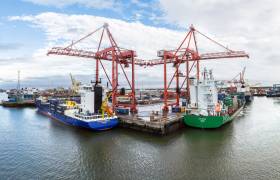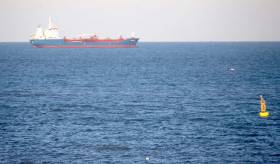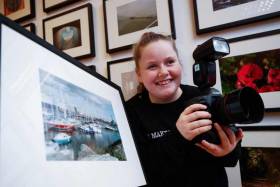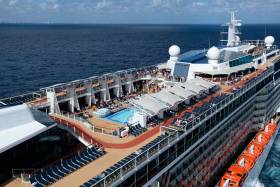Displaying items by tag: Dublin Port
'Royal Princess' Crowns Record Cruise Season, Dublin Port Announces 151 Cruise Calls for 2018
The 330m Royal Princess cruise ship arrived in Dublin this afternoon carrying more than 3,000 passengers and crew. Her arrival kickstarts a record cruise season for Dublin Port with 151 cruise calls confirmed for 2018, bringing just over 270,000 visitors to the city.
The Royal Princess will hold a commanding presence in the city’s port with her size more than two-and-a-half times the length of Dublin’s Spire (which stands at 121 meters) and her 66-meter height making her taller than Liberty Hall. The ship also holds the prestige of being christened by The Duchess of Cambridge Kate Middleton.
2018 Cruise Season Highlights
Among the 151 cruise calls confirmed for 2018, there are nine maiden calls. This year 23 cruise calls will feature ships longer than 300m including the 330m Regal Princess on September 13th. Dublin Port is increasingly attracting the largest ships in the world’s fleet emphasising Dublin’s attraction as a popular destination on the itineraries of all the largest cruise line companies.
New for 2018 is a mini-season of five full turnaround cruises that will see more than 14,000 people start and end their cruise holiday in Dublin Port on board leading luxury liner Celebrity Eclipse. Beginning last Sunday (April 29th), Celebrity Eclipse became the first major cruise ship to call Dublin a “home port”. Underscoring the growing trend towards home-porting, this year’s cruise season also features 17 further partial turnarounds, meaning cruise passengers can either start or end their journey at Dublin Port.
Economic Benefit
Growth in home-porting brings added economic benefit to Dublin City and the surrounding counties, as turnaround passengers typically extend their stay by three to four days either side of their cruise departure or arrival date. The five full turnarounds and 17 partial turnarounds will bring an additional €10 million boost to the City’s tourist earning as passengers seek out luxury hotel accommodation, dining, retail and visitor experiences. Combined with port of call passengers, the overall economic contribution of Dublin Port’s 2018 cruise season to the local economy will surpass €50 million.
Royal Princess in Overview
Today, the Royal Princess was welcomed into port by the sights and sounds of entertainment from Irish dancers and drummers as passengers disembarked for a day’s sightseeing and shopping around the city.
Having arrived from Cobh, the Royal Princess will depart for Belfast at 6pm tomorrow night (Saturday 5th May) before spending nine days at sea and arriving at her final destination of Southampton. It is all part of a 28-night crossing originating in Fort Lauderdale in Florida.
On board, guests enjoy luxury accommodation, a choice of restaurants, cafes, bars and nightclubs, as well as a spa, solarium and fitness centre, rock climbing wall, running track, basketball court and a driving range, in addition to swimming pools, cinemas, art gallery, theatre, shopping mall and casino.
Pat Ward, Cruise Business Manager, Dublin Port Company, said: “We are pleased to announce a record cruise season for Dublin Port, with 151 cruise calls and more than 275,000 visitors confirmed for 2018. We are seeing growing demand for Dublin Port on passenger itineraries from the world’s leading cruise lines, with more requests to accommodate larger ships and strong demand for turnarounds. An estimated 90% of turnaround passengers will fly into Dublin Airport to begin their cruise holidays, and these passengers alone account for one-fifth of the €50 million boost to the local economy from cruise tourism this year. As our cruise business evolves, Dublin Port Company remains firmly focused on future-proofing our infrastructure to accommodate larger and larger ships of all types including cruise ships, passenger ferries and cargo ships.”
Ship statistics
Christened by The Duchess of Cambridge Kate Middleton in 2013.
Length: 330 meters
Height: 66 meters
Capacity: 3,560 guests and 1,346 crew.
Number of decks: 19
Guest cabins: 1,780
Tonnage: 141,000
Inaugural Cruise: 16th June 2013
MV Celine, the world’s largest short sea Ro-Ro ship, was christened yesterday in a ceremony at Dublin Port with guest of honour, An Taoiseach, Leo Varadkar TD, Godmother to the new ship, Geraldine O’Reilly, and the port’s chaplains. The formal ceremony is a long-held tradition intended to bring good fortune to the ship and involves breaking a champagne bottle against the hull as the ship is christened.
To mark the occasion, new Irish music commissioned by Dublin Port and performed by John Sheahan of the Dubliners and Colm Mac Con Iomaire of the Frames premiered at the ceremony, heralding the ship’s naming in front of invited guests representing her Luxembourg-based owner CLdN and the wider European shipping industry.
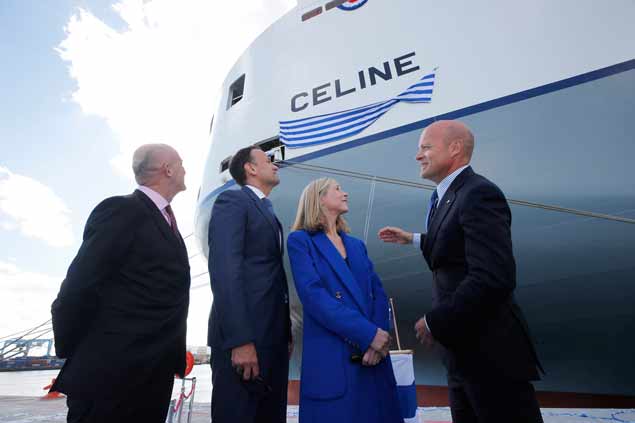 Pictured at the Port ceremony was Eamonn O'Reilly CEO, Dublin Port Company, An Taoiseach, Leo Varadkar TD, Godmother to the ship, Geraldine O’Reilly and Christian Cigrang, CEO, CLdN. MV Celine, the world’s largest short sea Ro-Ro ship
Pictured at the Port ceremony was Eamonn O'Reilly CEO, Dublin Port Company, An Taoiseach, Leo Varadkar TD, Godmother to the ship, Geraldine O’Reilly and Christian Cigrang, CEO, CLdN. MV Celine, the world’s largest short sea Ro-Ro ship
ABR Project Milestone
With a capacity of 8,000 lane-meters, MV Celine represents the next generation of super ferries servicing Dublin Port. Significantly, her arrival marks a new milestone in the multi-million-euro ABR Project to futureproof Dublin Port. Such is her size, MV Celine would not have been able to call into Dublin Port had development works on three kilometres of berths not already commenced.
The 235m long ship was constructed in South Korea’s Hyundai Mipo Shipyard
The 235m long ship was constructed in South Korea’s Hyundai Mipo Shipyard before being deployed to her homeports of Zeebrugge and Rotterdam. In October 2017, MV Celine made her maiden call into Dublin, providing additional capacity for customers trading with Continental Europe via the ports of Zeebrugge and Rotterdam.
Cargo volumes at Dublin Port reached a new record in 2017 as 36.4 million tonnes passed through the port including one million Ro-Ro units. CLdN’s direct freight services to Continental Europe is providing the capacity for this increasing demand with importers and exporters seeking alternatives for the efficient movement of goods, particularly with the reality of Brexit looming.
Q1 2018 Trade Figures
New figures released today show that cargo volumes at Dublin Port grew by 3.4% in Q1 2018 to exceed nine million gross tonnes for the quarter. Imports for the first three months of the year rose by 4.3% while exports increased by 2.1%. Most of the port’s cargo is comprised of freight trailers and containers and both sectors showed continued strong growth, with Ro-Ro up by 2.5% and Lo-Lo container volumes ahead by 5.3%.
On the passenger and vehicle side of the business, imports of trade vehicles in the first three months jumped by 14.2%, while passenger volumes climbed by 8.6%. Similarly, the number of tourist vehicles grew by 6.4%. Furthermore, Dublin Port’s cruise business will see 154 cruise ship arrivals, bringing a record-breaking 275,000 visitors to the city this year, including 10 maiden calls and five full turnaround cruises.
Dublin Port's Financial Dividend
Dublin Port has also confirmed that it will pay a dividend to the State of €12.2m in 2018, bringing the aggregate dividend payment since 2007 to €113.4m. The dividend follows a strong financial performance in 2017, during which turnover grew by 4.7% to €85.5m and Profit after tax increased by 3.9% to €40.6m.
An Taoiseach, Leo Varadkar, TD said: “It is a pleasure to be here today in Dublin Port for the christening of this magnificent new vessel, the MV Celine. I would like to congratulate CLdN on its continued commitment to providing enhanced cargo shipping into and out of Ireland. I also congratulate their environmentally friendly approach by developing a vessel that allows for dual fuel propulsion and lower carbon emissions. The MV Celine is the largest short-sea roll-on/roll-off vessel in the world and will strengthen Ireland’s trade links with Europe by providing direct services from Dublin to Rotterdam and Zeebrugge.”
A representative of CLdN, said: “Choosing to name CLdN’s first of the next generation of Ro-Ro vessels, MV Celine, in Dublin is testament to CLdN’s belief in our Irish / Continental trade lane and appreciation of the support given over the past decade by Dublin Port Company and our dynamic team in Ireland.
“CLdN commenced services to Dublin Port in October 2009 and these have grown strongly as the Irish economy recovered to the point today where we offer seven calls weekly from Zeebrugge and Rotterdam.
“The timing of MV Celine’s delivery is opportune, allowing CLdN to be well positioned to develop the Irish / Continental trade lane offering a viable and direct alternative to the UK landbridge.”
Eamonn O’Reilly, Chief Executive, Dublin Port Company, said: “It is an honour for Dublin Port to host the christening of MV Celine at such an exciting time for Dublin Port. The addition of new ships and sailings shows the shipping sector’s resilience and ability to adapt to changing customer needs, particularly in response to Brexit. We expect MV Celine will mark the beginning of additional new services to Continental Europe from Dublin Port over the coming years.”
Dublin Port trade figures for Q1 show continued strong growth
“Our trade figures for Q1 show continued strong growth, with cargo volumes up 3.4% as demand continues apace for the efficient movement of goods and people through Dublin Port. This is a particularly strong performance given the disruption of Storm Emma when the business of Dublin Port effectively stopped for two days.
“I am pleased that Dublin Port’s multi-million-euro investment programme has already delivered the first of new berths to accommodate customer investments in new vessels and routes, and MV Celine’s christening marks an important milestone in this regard.
“Based on our Masterplan, Dublin Port is investing €132m this year alone to ensure the timely delivery of new infrastructure and additional capacity to further facilitate Ireland’s trading needs. Capital investment of €1 billion is planned over the next decade.”
Dublin Port is investing €132m this year alone to ensure the timely delivery of new infrastructure
MV Celine is the newest vessel to join CLdN’s network, which specialises in short sea Ro-Ro cargo, and a second 8,000 lane-metre vessel, MV Delphine, has been delivered in January 2018 as the company further expands its fleet and operations in Europe.
CLdN currently operates 25 Ro-Ro vessels, offering more than 135 weekly sailings between the ports of Zeebrugge, Rotterdam, London, Killingholme, Dublin, Gothenburg, Esbjerg, Hirtshals, Santander, Porto, Flushing and Dagenham.
#DublinPort- Expansion in Dublin Port will happen at a faster than expected pace over the next 20 years as population growth boosts volumes passing through the country's main goods gateway, the semi-state company behind the port said.
As the Independent.ie writes, growth however will have to be accommodated without a physical expansion beyond the existing docks - ruling out reclamation or a major move.
In a revised masterplan published yesterday, Dublin Port Company said Ireland's biggest port - now needs to expand based on an assumption of 3.3pc annual growth in volumes between 2010 and 2040. That's higher than the 2.5pc annual growth pencilled in back in 2012.
"The past and projected growth to 2040 is in large part due to the growth in the country's population," the revised masterplan noted.
Dublin Port Company said that the annual volume of goods through the gateway is expected to rise to 77.2 million gross tonnes in 2040, from 2.9 million tonnes in 1950.
The current masterplan was first published in 2012. Since then, two major elements of the plan have got underway. They are the €277m Alexandra Basin Redevelopment scheme and the development in a so-called "inland port" on a 44-hectare site near Dublin Airport.
For further reading on this story,click here.
Wave Generator Test Buoy Deployed in Scotsman's Bay
The Commissioners of Irish Lights have deployed a temporary buoy in Scotsman’s Bay in south of Dublin Bay.
The buoy has been deployed to test a wave generator system. The buoy is an IALA Special Mark, yellow in colour, bearing a yellow ‘X’ topmark with the light characteristic Fl.Y.5s.
The buoy is located on the following position: Latitude 53°17.519’N, Longitude 006°07.136’W, a location in an area where Dublin Bay Sailing Club will set marks for their Summer Season starting in April.
The Commissioners of Irish Lights buoy will be on station for approximately 3 months, according to a Dublin Port Company notice from Harbour Master Michael McKenna that is downloadable below.
Dublin Port Company has today reported full year trading figures for 2017. The latest figures show that cargo volumes through Dublin Port hit record levels for the third successive year with growth of 4.3% to reach a new record level of 36.4m gross tonnes in 2017. This brings overall growth at Dublin Port in the five years since economic recovery began in 2013 to +30.1%.
To facilitate future growth, Dublin Port continues to invest in new infrastructure based on its Masterplan to 2040 and a programme of works is already underway. The company invested €75 million in port infrastructure in 2017 and plans to invest a further €132m during 2018. Thereafter, investment plans will need to accelerate to ensure that Dublin has sufficient port capacity for the years ahead.
Looking at the 2017 trade figures in detail, imports grew by 3.9% to 21.5m gross tonnes while exports grew more strongly by 4.9% to 14.9 million gross tonnes. Containers and freight trailers account for 83% of all cargo and both the Ro-Ro and Lo-Lo sectors grew strongly. Ro-Ro grew by 5.0% in 2017 to almost one million Ro-Ro units (992,000). Lo-Lo container volumes grew by 5.2% to 698,000 TEU.
Imports of new trade vehicles were down by -4.6% in 2017, reflecting the large increase in used cars being brought into Ireland from the UK, driven by the weakness in Sterling. Year-on-year, the number of imported trade vehicles fell from 104,185 to 99,383.
Bulk liquid volumes, comprising mostly petroleum products, grew strongly by 6.6% to 4.3m gross tonnes driven by increasing road transport. On the other hand, Bulk solid commodities, such as animal feeds and grain, declined marginally by -1.0%.
Passenger volumes on ferries grew for the second year in a row with passenger numbers ahead by 1.8% to 1,846,553. Similarly, the number of tourist vehicles grew by 1.9% to 514,908.
In addition, Dublin Port’s cruise business grew strongly with 127 cruise ship arrivals and growth of 32% in visitor numbers, breaking the 210,000-mark for the first time. Importantly, cruise ships are getting bigger and the average cruise ship calling at Dublin Port increased in size by 13.3%, from 39,946 gross tonnes to 45,270 gross tonnes.
Commenting on the results, Dublin Port’s Chief Executive, Eamonn O’Reilly, said:
“Growth of 4.3% in 2017 confirms that the longstanding trend of compounding annual growth in Dublin Port is back. Every year from 1993 to 2007 was a record year in Dublin Port. In the past three years we have seen this pattern re-emerge, with 2017 the third year in a row for record growth. We are projecting another record year in 2018 with growth of about 5%. Dublin Port’s growth is driven by domestic demand and both population growth and a stronger economy will continue to drive volumes up for the foreseeable future.
“Dublin Port’s multi-million euro infrastructure investment programme is matching our customers’ continuing investments in new ships. Irish Ferries has committed €165m in a huge new ship for the Dublin-Holyhead route due by mid-2020. Later this year, the €150m W.B. Yeats will commence a service from Dublin to Cherbourg. In October last year, CLdN introduced the enormous 8,000 lane metre MV Celine on its Dublin to Zeebrugge / Rotterdam service.
“While BREXIT brings uncertainties and challenges to our business, the combination of investments by our customers and by Dublin Port is underpinned by a shared confidence in the future. Over the next two months, we will finalise our plans for the required re-introduction of border controls on trade with Britain and I am confident that the controls required will not significantly hinder the movement of goods or people through Dublin Port.”
Dublin Port Company: A Year in Review 2017
2017 has been a very productive year for Dublin Port. There has been sustained, significant growth across the business, from cargo to cruise, and it has also been a year of firsts on a number of fronts.
Trade
Latest trade figures show growth of 4.2% to the end of Q3 2017. A continuation in the current rate of growth to year–end would see 2017 become a third successive record year for Dublin Port. Total throughput (imports and exports) for the nine months to the end of September was 27.1 million gross tonnes, with 5,932 ship arrivals during the period. This is the fifth year in a row for Dublin Port to see substantial growth in the first nine months. Within that, growth was particularly strong in Ro-Ro freight with 736,462 units in the first nine months, an increase of 5.3% on the previous year. Meanwhile Lo-Lo containers grew by 4.1% to 515,718 TEU. Overall, volumes in Dublin Port have grown by 30.1% in just five years.
Infrastructure Development
With a return to the trend of year-on-year increases seen in the decades before the crash of 2008, and five years of consistent growth, works to increase the capacity of Dublin Port are advancing on the basis that growth will continue for many years to come. Works progressed throughout 2017 on both the Alexandra Basin Redevelopment (ABR) Project and the development of Dublin Inland Port located on a 44-hectare site just 14km from the Port. During the year, we also turned our attention to our next major project which, like all major port development projects, is being guided by Dublin Port’s Masterplan 2012-2040. The next significant project will focus on providing much needed additional capacity for Ro-Ro freight and container traffic to the UK, and increasingly to Continental Europe.
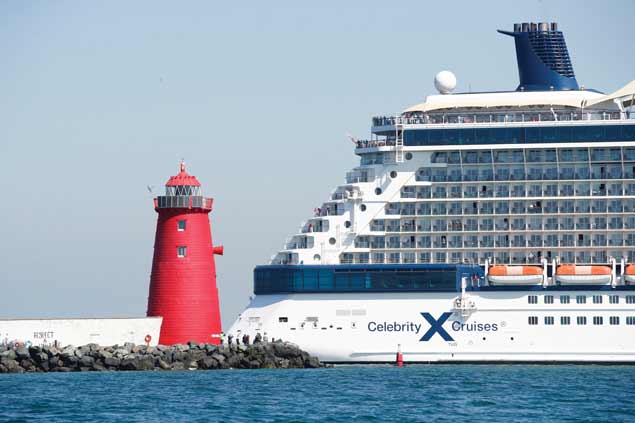 The 317m Celebrity Eclipse cruise arriving in Dublin on May 10 carrying over 4,000 passengers and crew on her maiden call to Ireland. The new arrival marked the start of Dublin Port’s 2017 cruise season that saw 130 cruise calls confirmed for Dublin Port this year, bringing over 200,000 passengers and crew to visit the city and benefit the local economy. Celebrity Eclipse will return to the city in 2018 when she becomes the first ship of a major cruise line to call Dublin Port a ‘home port’ Photo: Conor McCabe
The 317m Celebrity Eclipse cruise arriving in Dublin on May 10 carrying over 4,000 passengers and crew on her maiden call to Ireland. The new arrival marked the start of Dublin Port’s 2017 cruise season that saw 130 cruise calls confirmed for Dublin Port this year, bringing over 200,000 passengers and crew to visit the city and benefit the local economy. Celebrity Eclipse will return to the city in 2018 when she becomes the first ship of a major cruise line to call Dublin Port a ‘home port’ Photo: Conor McCabe
Homeporting - A New Departure
Four consecutive years of rising cruise tourism passengers to Dublin Port, and maiden calls by leading cruise lines, including MSC Cruises’ MSC Splendida, Holland America Line and Disney Cruise Line, have cemented Dublin Port’s position as a marquee cruise tourism destination on international passenger itineraries. Confirmation that Celebrity Cruises will base a number of Celebrity Eclipse turnarounds in Dublin next year, and news this year that one of the company’s newest Solstice class ships, Celebrity Reflection, will also homeport from Dublin in 2019, highlight growing momentum for turnaround cruises in the capital and, with that, bright prospects for the city’s wider tourism offering.
Opening Up Port Centre
An emerging port heritage trail now forms part of the city’s own tourism offering, and 2017 has been a landmark year in furthering its development with the opening up of Port Centre. The new public realm surrounding the company’s headquarters on Alexandra Road marks the largest physical intervention by the company to reintegrate Dublin Port with the city in 35 years and follows the reimagining of Dublin Port’s Diving Bell on Sir John Rogerson’s Quay.
The stone wall boundary surrounding Port Centre has been removed at intervals and replaced with new gate-like structures made from pre-rusted Corten steel. Opened, the gates reveal a newly reconfigured public plaza featuring a four-tonne stainless steel ball inspired by the Time Ball, which originally stood on the roof of the Ballast Office at the corner of Aston Quay and Westmoreland Street, and would drop to signal Greenwich Mean Time to ships in port.
Completing the new environs of the 1981 Scott Tallon Walker building is Crane 292, a refurbished 1960s Stothert & Pitt crane that once served as a workhorse, loading and unloading bulky material from ships at Alexandra Quay from 1964 through to its retirement in 1997. Restored to its former glory, Crane 292 is illuminated at night, providing a new addition to the docklands skyline.
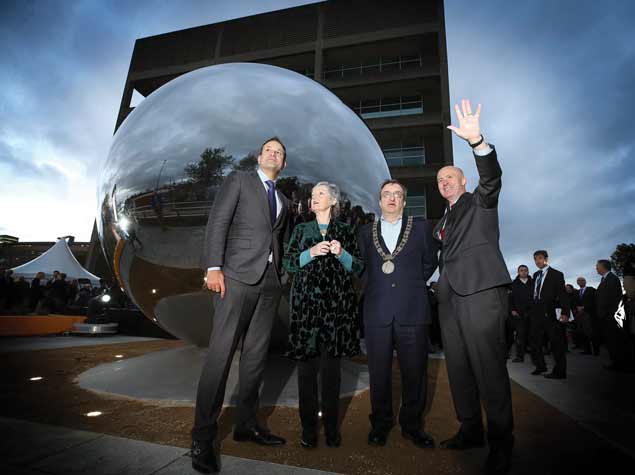 An Taoiseach Mr. Leo Varadkar TD, (left) with Lucy McCaffrey, Chairperson of Dublin Port Company, Lord Mayor of Dublin, Mícheál Mac Donncha and Eamonn O’Reilly, CEO, pictured after unveiling the new art insulation entitled “The Sphere” at the official ‘opening up’ of Port Centre following completion of a 12–month project to soften the Port’s boundaries with the city Photo: Conor McCabe
An Taoiseach Mr. Leo Varadkar TD, (left) with Lucy McCaffrey, Chairperson of Dublin Port Company, Lord Mayor of Dublin, Mícheál Mac Donncha and Eamonn O’Reilly, CEO, pictured after unveiling the new art insulation entitled “The Sphere” at the official ‘opening up’ of Port Centre following completion of a 12–month project to soften the Port’s boundaries with the city Photo: Conor McCabe
New Perspectives on Port – River – City
The modern port, its rich history and links with Dublin City and the River Liffey provided the inspiration and theme for Port Perspectives, Dublin Port’s visual arts commissioning series throughout 2017. During the year, the works of acclaimed Belgian artist Eugeen Van Mieghem went on display to Irish audiences for the first time in a major new exhibition at Dublin City Gallery The Hugh Lane, showing life in the Port of Antwerp at the turn of the 20th century.
Inspired by the exhibition, local community groups and schools saw their own works then go on display in the gallery. Sketches, watercolours, pastels and collages capturing images and memories from life at Dublin Port were created by young and old during a series of Drawing Club workshops. The artists ranged in age from as young as 11 to almost 80-years-old, and represented the communities of East Wall, Ringsend and Pearse Street.
Port Perspectives also featured new artwork from commissioned artists, including Sheelagh Broderick, whose Port Walks podcasts give recreational walkers along the Great South Wall an insight into working life aboard the vessels that enter the Port each day. Silvia Loeffler’s Transit Gateway mapped the changing shape of Dublin Port over the centuries, from its beginnings as a medieval shoreline to present day, in a series of seminars and accompanying artworks, while site-specific moving image installations were curated by Alice Butler & Daniel Fitzpatrick of Aemi and artist Cliona Harmey.
Ro-Ro in Focus
In a new development, CLdN’s MV Celine, the world’s largest Ro-Ro freight vessel, made her maiden call to Dublin Port in October, marking the start of a new service between Dublin and the ports of Zeebrugge and Rotterdam. With a capacity of 8,000 lane-metres carrying over 600 freight units, she will provide additional capacity and flexibility for customers trading with Continental Europe, particularly post–Brexit.
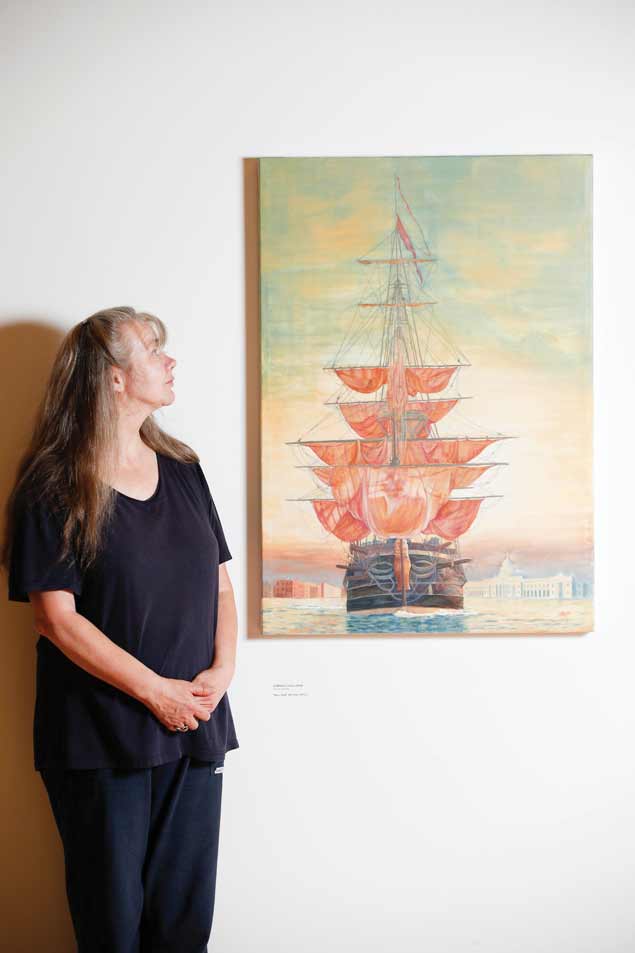 Dympna O'Halloran viewing her art work hung in Dublin City Gallery The Hugh Lane as part of Dublin Port's Port Perspectives Drawing Club Project in Ringsend and Irishtown Community Centre. More than 30 aspiring artists from Dublin's north and south inner city saw their art work displayed in Dublin City Gallery
Dympna O'Halloran viewing her art work hung in Dublin City Gallery The Hugh Lane as part of Dublin Port's Port Perspectives Drawing Club Project in Ringsend and Irishtown Community Centre. More than 30 aspiring artists from Dublin's north and south inner city saw their art work displayed in Dublin City Gallery
In Review
Earlier this year, Dublin Port Company published its report on the public consultation process for the first review of the company’s Masterplan 2012-2040, which makes provision for periodic reviews. The process, which involved extensive outreach to a wide range of stakeholders, will inform the revised Masterplan to be published. In the meantime, Dublin Port Company has undertaken a number of environmental, cultural, leisure and transport studies and assessments arising from the consultation process before finalising the review.
The significant growth of recent years meant that it was timely to review the Masterplan in 2017 and thereby ensure that the framework guiding the Port’s future development continues to reflect changing circumstances such as developments in policies governing planning, national transport, the environment and the economy.
Keep up to date with all the latest Dublin Port News on Afloat.ie here
Dublin Port Company Brings ‘My Port, River, City’ Student Photo Exhibition to the CHQ Building
Students from Ringsend College reveal their take on Dublin as part of an exciting new photo exhibition entitled ‘My Port, River, City’ which opens to the public today at the CHQ Building. The exhibition which runs until Sunday 10th of December is free of charge and showcases new works from over 100 budding young photographers aged 12 to 17 years old – for most of the students involved this represents their first official exhibition.
This special project is supported by Dublin Port Company’s Port Perspectives arts commissioning series and included a gift of digital camera equipment to Ringsend College to enable the students to take part. The students had the opportunity to work with professional photographer Mella Travers who mentored the group over a eight-week period as they developed their own bank of photography in response to the brief ‘My Port, River, City’.
The brief stems from Dublin Port’s drive to reconnect Port and City and to encourage new audiences to explore these areas through the medium of the arts. It entailed the students setting out to explore the greater Port area from the Great South Wall into the bustling Docklands. The students managed to capture unique moments across Dublin from windswept natural beauty to everyday moments in the City that go unnoticed.
Krystian Kilarski, a 4th year student spoke about how the project helped him develop a connection to the Port, River and City; “I live in Balbriggan and travel into Ringsend College each day. My family moved to Ireland from Poland seven years ago so I never really knew much about these areas, I barely even realised there was a Port! Since I took part in this project I have been able to develop a real connection to the Port, River and City.”
Abbie Cassidy, a 1st year student said; “It really is brilliant that we get to have our photos exhibited in the CHQ Building; it is a boost to my confidence to my see my photo there. It shows that teenagers can do some amazing things when we are given the opportunity.”
Darrel Poole, a 3rd year student said; “It has been great learning how to use the cameras with Mella, we’ve learned how to properly frame a shot, about lighting and how to use the cameras correctly. I think it is a skill everyone should learn.”
Mella Travers, a professional photographer has long ties to Ringsend College and speaks highly of the school’s commitment and holistic approach to their students’ education.
Mella Travers, Photographer, spoke about the experience of mentoring the students of Ringsend College; “The students put the hard work in and it has been wonderful to help foster their talent. This has been a very rewarding project just seeing the students grow in confidence in their abilities and believing in themselves.”
Eamonn O’Reilly, Dublin Port Company Chief Executive, said; “For decades, Dublin Port touched almost every family living in the vicinity of the north and south quays. This has been a very special project for us and we believe in putting time and support into local communities and the next generation. Not only are we helping these students learn a new skill we are encouraging them to make a connection to the Port, River and City and I would encourage people to visit CHQ this weekend for an inspiring exhibition.”
My Port, River, City will be open to the public from Friday 8th to Sunday 10th December between 11am – 4pm at The CHQ Building, 1 Custom House Quay, North Dock, Dublin and admission is free.
Seatruck Ferries Celebrate 10 Years of Operation in Dublin Port
#ferrynews - Freight ferry operator on the Irish Sea, Seatruck Ferries celebrate 10 years of service using Dublin Port from where the shipping company's traffic volumes have grown exponentially.
From small beginnings in October 2007, Seatruck had a single ship service using freight ferry ‘Celtic Star’. The ro-ro ship had previously ran for another operator Celtic Link Ferries on the Irish Sea. This operator no longer remains in business.
In that first year, Seatruck transported just over 3,000 units of freight from Dublin. Roll on a decade later and compare that figure to just under 21,000 units in October 2017, representing growth of well over 500%. According to IRN Freightstat, the operator are now one of the largest freight movers in the capital port.
In the busy midweek period Seatruck operate 4 daily services to Liverpool and a daily service to Heysham. Seatruck also operate on the Warrenpoint - Heysham route which commenced in 1996.
With driver shortages continuing Seatruck are expecting an ongoing switch to unaccompanied trailer movements which they specialise in with their purpose built freight only ferries.
CEO of Seatruck Alistair Eagles comments; “10 years on from the commencement of our services into Dublin port we are very much focusing on the next steps to ensure that we can continue to help our customers save money and use their equipment and drivers more efficiently. Seatruck is fully committed to our freight only model and we are planning for a continued industry switch away from the driver accompanied, short sea mode.
Our Dublin services are an extremely important part of our route network and I on behalf of everyone at Seatruck would like to personally thank all of our customers for their support”
In December, a new loading ramp will be installed in the Port of Heysham which will further enhance the operator's Irish Sea services from the UK Port, which is now directly linked to the motorway network via the new £130m M6 Link.
Seatruck are working closely with the relevant authorities in Northern Ireland on the Newry Southern Relief Road. The project will link Warrenpoint Harbour directly to the Belfast - Dublin motorway.
Dublin Port Becomes a Regular Feature for Celebrity Cruises
2019 is set to be an exciting year in the Irish cruise calendar as Celebrity Cruises confirms that Dublin Port will become a regular fixture. With five turnarounds in the port, Celebrity Refection will call Dublin home from May to June 2019.
In 2018 Celebrity Cruises becomes the first major cruise line to homeport a ship in the city when Celebrity Eclipse arrives in Dublin in April 2018, offering a mini season of five sailings. Due to the success of this inaugural season, Celebrity Cruises is continuing to feature Dublin as one of its prestigious homeports in 2019 and bringing a newer ship to Ireland. In 2019 over 15,000 holidaymakers will start their cruise holiday in Dublin with CelebrityCruises.
Celebrity Cruises will base the 3,030-guest Celebrity Reflection in Dublin in early summer 2019 offering a series of eight, 10, 11 and 12 night sailings. Cruises will sail to Iceland, destinations throughout Ireland, in the Norwegian Fjords and around the British Isles.
Celebrity Reflection launched in 2012 and is currently the newest ship in the Celebrity Cruises fleet. Featuring a real grass lawn on the top deck with private cabanas and the luxurious Reflection Suite – a one-of-a-kind two bedroomed suite with a shower cantilevered out above the ocean, and private butler service – Celebrity Reflection is one of the most stylish ships at sea.
The exciting expansion of Celebrity Cruises’ Ireland programme follows strong guest demand for cruises from Dublin, and the support of the Irish travel industry including travel agents and Dublin Port.
Lorraine Quinn, head of sales, Ireland, Celebrity Cruises, explains: “Sailings starting in Ireland from Dublin Port have been popular with our guests from all over the world. We are really pleased with the performance of the 2018 season for Celebrity Eclipse, and our 2019 deployment of a slightly larger ship in Celebrity Reflection to Dublin sees an increase in the number of people who will sail from this great city. Confirming our ongoing commitment to Ireland is a huge thank you to those who have aided Celebrity Cruises in becoming the first major cruise line to base a cruise ship in Dublin. I can’t wait to be part of the huge welcome that our guests will receive in 2018, 2019 and beyond.”
Pat Ward, Head of Corporate Services, Dublin Port Company adds: “We are delighted that Celebrity Cruises has chosen Dublin as the homeport for the deluxe Celebrity Reflection during 2019 confirming Dublin City as a marquee destination for the world’s largest cruise lines. Celebrity Reflection, measuring 319m long and boasting 14 decks, will be one of the most impressive cruise ships to arrive into Dublin Port. Our location at the heart of the city means that guests can maximise their time in the capital, relaxing in one of our many fine hotels while taking in the city’s sights, shops and attractions with ease. Dublin Port’s cruise business is growing from strength to strength. We are already on track for a record year in 2018, and with work on our Alexandra Basin Redevelopment Project having commenced, the future of cruise tourism to the capital is now secure.”
Both Celebrity Eclipse and Celebrity Reflection are part of Celebrity Cruises’ newest Solstice Class of ships, all introduced between 2008 and 2012. In addition to luxury guest accommodations, designer boutiques, extensive bars and restaurants, they also feature a real grass lawn on the top deck. With many awards particularly for its food and wine, Celebrity Cruises boasts the largest and rarest collection of wine at and sea and host of exclusive restaurants on-board all overseen by a Michelin-starred executive chef.
Celebrity Cruises continues to grow and expand its fleet with a new class of ship currently under construction. The first of those ships – Celebrity Edge – will enter service in December 2018.
Heads Up On Eden Quay: Historic Crest of the 'City of Dublin Steam Packet Company'
#CityOfDublin - It would be hard not to have noticed in particular as a Dublin bus commuter using services at Eden Quay the historic crest of the former City of Dublin Steam Packet Company, writes Jehan Ashmore.
The ornate masonry of the crest depicts the City of Dublin S.P.Co that was established in 1823 and later incorporated from 1833. The crest is to be found on the facade of 13-15 Eden House, on the first floor of the steam packet's former head office. Notably, such a crest is a very rare example in Dublin city and which has such historic shipping connections dating almost 200 years ago.
Facing almost opposite of Eden House are further bus stops located on the quay from where past Dubliner's could conveniently board City of Dublin 'steamers' to the rest of the UK. Noting that Ireland then remained as part of the Union.
The crest is of historical importance given the rarity of such architectural decorative features relating to our shipping heritage. Such an example should be recognised more so in the public domain as part of our national maritime past.
Eden House is on the corner with Marlborough Street where the Abbey Theatre's front entrance is located. To mark the significance of the 1916 Easter Rising centenary last year, images of leading historical figures were placed on the ground floor windows of Eden House. Currently they are adorned with those concerning productions held at the cultural institution also known as the National Theatre of Ireland.
As for the crest itself, the earliest date depicted is 1823 and this refers to when the Irish owned passenger services began when Charles Wye Williams inaugurated the Dublin-Liverpool service. In the following year this route was served by steamships City of Dublin and City of Liverpool.
Afloat will have a follow up on the crest and a more in depth background about the history of the City of Dublin Steam Packet. Also examined will be the relationship with other Irish Sea operators, among them B&I Line that has links to present day ferry operators connecting Dubin with Liverpool and Holyhead.
As developments continue in an increasingly changing city notably downriver in the 'Docklands', it is in this predominantly financial quarter where only a handful of further historical shipping related 'listed' buildings remain standing. These examples along the inner quays recalls an era from Dublin's older port.
The last regular trading ships from this part of the port were Guinness tankers that ceased operations in 1993. Originally the stout company loaded ships on the north side along Customs House Quay which was connected by barges upriver from St. James Gate brewery until this river trade ended in 1961. This led to road tankers taking over to supply the final pair of ships, The Lady Patricia and Miranda Guinness that transferred southside to Sir John Rogersons Quay.
As for Eden Quay's more central city location is located between O'Connell Street Bridge, the capital's main thoroughfare and the Butt Bridge completed in 1932. A previous bridge of the same name had been built at the same location albeit it was a 'swing' bridge that permitted navigation to shipping in the days of sail and steam.
It is along this stretch of the inner city Liffey quays is where commercial traffic exists in the present day albeit confined to the river. This been in the form of a single operator that been Dublin Discovered boat tours. Their excursion craft, Spirit of Docklands (see photo-story) embarks tourists from a berth pontoon at Batchelors Walk. From there the low-air draft craft regularly plies upriver to the Ha'Penny Bridge and as far as the Tom Clarke toll-lift bridge downriver where the modern port begins.




























